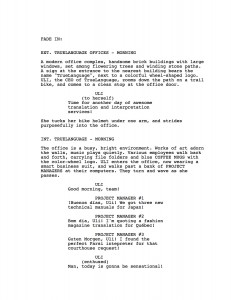This content has been archived. It may no longer be relevant
It’s almost Oscar Night – will you be tuning in?
Cinematic magic, movie-star glamour, the excitement of awards season… who hasn’t gotten caught up in it at some point? Sometimes it seems that in one way or another, all roads lead to Hollywood, even in the language services industry. The January 2014 issue of the ATA Chronicle contained an interesting and informative article by Christine Kretschmer, “Translating Screenplays”, which gave a thorough look at what goes into writing and translating a movie script, why a movie script would need to be translated, and how such a project should be approached. This got us thinking about screenplays, what sets them apart from other document types, and this led us into thoughts about different issues.
Ever seen a screenplay? Here’s a sample page, from a movie that would surely break box office records (click for a closer look):
Looks simple, doesn’t it? Not so fast. Simple in terms of concept, sure. In those terms, a screenplay is a simple document with a dual purpose. It tells a story, and tells how that story should be visualized. But let’s talk about something more prosaic, yet equally important. Let’s talk about formatting.
As you can see, a screenplay page looks like nothing else. The font is Courier – in screenwriting, the font is always Courier. Why? Because it’s clear, large, and easy to read. The text is broken up into fixed sections, each with a specific task, and each of these sections has very strict formatting guidelines. For instance, every scene has a scene heading or slugline (“INT. TRUELANGUAGE – MORNING”), which is in all capitals and aligned with the left margin. Scene descriptions are also aligned with the left margin, but written in upper and lowercase characters. You’ll notice that character names and dialogue appear in the middle of the page, with names in caps and dialogue in regular print. The formatting of these elements, right down to their position on the page and the amount of white space between them, is a non-negotiable industry standard. You may have thought once or twice (or daily) that you have a screenplay in you… well, know that if you do write it and shop it around, if it’s not formatted in just the right way, any agent who receives it will send it right to the “circular file”.
These formatting guidelines are not random. Each margin and indent has a justification. Let’s say you write a screenplay, find representation, and negotiate a sale – congratulations! What happens next is something most writers would never want to see. Your script will be distributed to a whole team of creative people, all with their own jobs to do, then cut to pieces and reassembled. This is necessary, and the formatting makes it easy. The director, production designer, director of photography and others will need to speed through the script, to gauge how many scenes there are, how many exteriors and interiors, how many sets have to be built… fortunately, they can train their eyes on the part of the page where the slugline lives, and roll right on through. If the team wants to attract the interest of, say, Anjelica Huston to play the female lead, she likely won’t have the time to read the whole script… but since the characters and dialogue are set apart the way they are, she can flip through looking for her potential character’s name, and make her decision. A screenwriter has to work within a template, and every aspect of that template has a raison d’être. It is the way it is, because a team of professional craftsmen and workers needs it to be that way.
In other words, a screenplay is a technical document, as much as an architectural blueprint or a user’s manual.
We don’t get much call for screenplay translation at TrueLanguage (although with the film industry’s growing presence in Atlanta, who knows?), but we do know a lot about technical documents of other types. In all of them, in translation as well as writing the source text, formatting is as essential as content. This is why we place such importance on subject matter expertise in translators and proofreaders, and why we ask our clients so many questions about style guides, templates, approved terminologies, etc. Even when the translation is letter-perfect, if a hypothetical English-to-Russian translated schematic goes out in the wrong shape, it won’t be accepted by the client. And nor should it be.
So, business owners and potential translation clients: when you’re lining up documents for translation, think about how clear your formatting requirements are, and consider formalizing them in a style guide to make available to anyone who’ll be handling your content. Your industry’s standard formatting may be second nature to you, but you can avoid problems and delays down the road by creating a reference document, in case it’s needed. Once you’ve got this, we and our expert translators can help you adapt it to the conventions of your target languages, if they differ.
Treat your documents like stars – you wouldn’t let them go on-camera looking less than their best, would you?



